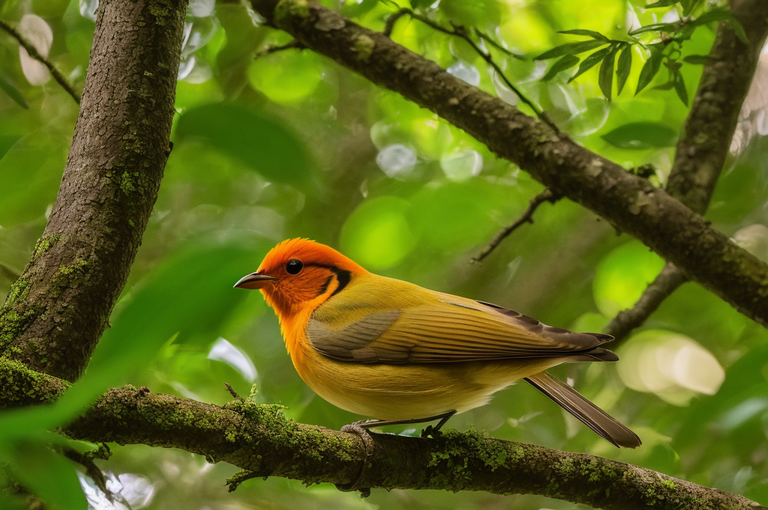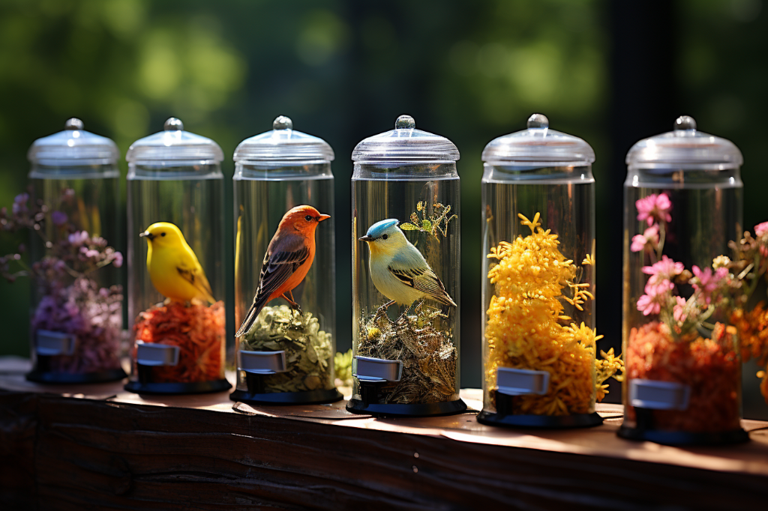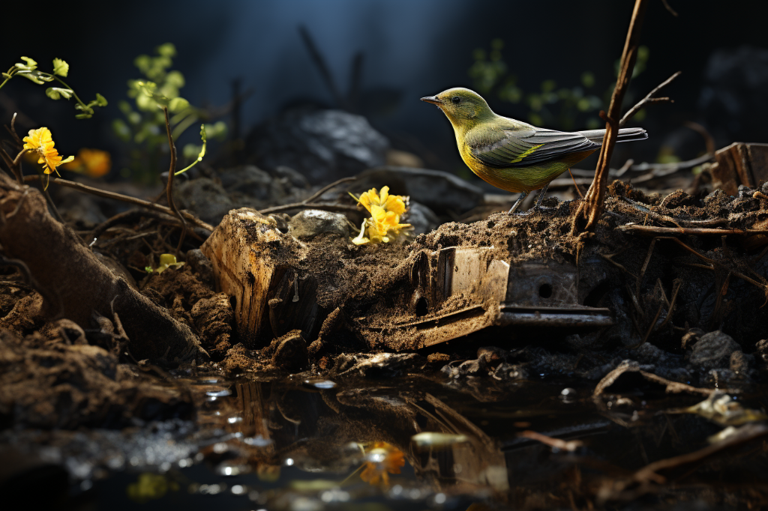The Revival of Bird Feeding: Innovations, Challenges, and Ecological Rewards

This article discusses bird feeding practices, advanced bird feeder technology, and its impact on bird behavior. It also covers disruptive squirrels, American Ornithological Society’s bird renaming activity, and certification for wildlife habitats.
History and Importance of Bird Feeding
Just as the first shaft of sunlight peeks over the horizon, my morning ritual begins with a euphonious symphony of chirps echoing through the Maine woods. The task cultivating a bond between us mankind and the wild birds in Maine not unlike rendering a narrative, whispering of our shared histories.
Evolution of bird feeding practices
Tracing back to antiquity, our penchant to nourish these avian gems stems from innate human empathy embracing the birds’ survival during harsh winters. Fast forward through the centuries, we’ve refined the art of feeding birds, making it a potent tool to study, appreciate, and ultimately protect these beautiful creatures. The ignited curiosity invoked by our feathered visitors in our backyards is truly a testament to the long history of bird feeding tradition.
Resurgence of bird feeding during the pandemic
The pandemic, a time of unprecedented isolation presented a heartening resurgence in bird feeding. As we retreated into the confines of our homes, the sight of warblers, sparrows, and jays fluttering around our feeders evoked trust, resilience, and a hint of freedom rendering our daily monotony to vibrate with life. The feeding ritual granted us a soothing birdsong amidst chaos, forging a tight knit bond with our feathered neighbors.
Positive and negative impacts of bird feeding
Much like the mixed flock at my feeder, the impacts of bird feeding practices exhibit a spectrum. On one hand, supplementary food provides nutrition safeguarding against harsh climates, boosting survival rates. Yet, altercations at packed feeders can disrupt delicate hierarchies and encourage disease spread. Bird feeding indeed maps onto the intricate ecology of the avian world, tipping the scale of survival in the face of relentless environmental changes.
Navigating through our shared history with birds, there’s an unmistakable layer of kinship, a spark bridging us to the enchanting avian universe. Let us tread on this path lightly, nurturing them, learning from them, and revering the vitality they bring into our everyday existence.

Technological Advancements in Bird Feeder Designs
Waking up to the symphony of Maine wild birds is a joy like no other, but the science of avian attraction isn’t as simple as tossing a few seeds about. Like everything else, bird feeding has also been touched by the graceful wings of technology.
Development in Bird Feeder Technology
The humble bird feeder has seen a sea of change, evolving from simple dishes to sophisticated structures equipped with innovative technology. From timed dispensers, automatic refills to solar powered designs, there is an increasing emphasis on technological advancements in bird feeding a grand testament to human ingenuity in attracting the elegant marauders of the skies.
Role of Technology in Enhancing Convenience for Bird Enthusiasts
For a bird enthusiast like myself, these advancements aren’t just about flashy features; they’re pathways to knowledge, and oh, the convenience! No more refilling feeders in the biting cold, or worrying about food being wasted in the rain. Now I can sit back, a hot cuppa in hand, reveling in the grandeur of the avian world, while technology takes care of the mundane tasks.
Counteracting Wildlife Disruptions: Squirrel Proof Feeders
Ah, the age old joust between bird watchers and squirrels! Isn’t it fascinating how the same creature can be an animated delight at one moment, and a pesky intruder the next? However, that’s a tale being rewritten by inventive squirrel proof feeders. These clever contraptions refute access to our furry friends, ensuring the personalized bird buffet stays just that a feast for the winged ones.
In the opulent high stakes game of bird feeding, technology provides the thrill empowering us to sit at the forefront, watching, learning, and marveling, at the magic woven by the creatures of the sky. It’s more than just a pastime; it’s a day to day study, a way of life, a dialogue with nature, punctuated by the whimsical serenade of Maine wild birds.

Renaming of Birds by AOS
Perched on my porch, observing wild birds unlikited, I recently stumbled upon a curious development within the academic circles of ornithology. The American Ornithological Society (AOS), notably, has been engaging in a systemic renaming of all English language bird names that were previously named after people.
Background of Bird Naming
The nomenclature of our feathered friends often reflects their physical attributes, geographical habitat or, as in this case, the names of people typically, the ornithologists who discovered them. It’s akin to etching their contributions permanently in the annals of avian history.
Rationale Behind Renaming Birds by AOS
As for the reasoning behind this comprehensive renaming effort, the AOS aims to disentangle the birds’ identity from the individuals they were named after. This action harbors no official statement of disregard or ingratitude towards these contributors. Instead, it is an attempt to shift the focus towards the avian wonders themselves, advocating a more holistic appreciation of their exquisite natural charm, free from the overshadowing human influence.
Impact of Renaming on Bird Appreciators
This move by the AOS can be observed as a paradigm shift, which might send a flutter through the bird appreciator community. It may mean adjusting to an entirely new catalogue of names, resembling an intricate bird song learned anew. Yet, it is also an opportunity. An invitation to begin afresh, to welcome these familiar creatures not as mere labels or tributes but as enchanting entities of nature in their entirety. It’s a matter of perspective, an opportunity to blend scientific curiosity with childlike wonder in a way that is distinctly Penelope.

Creating Certified Wildlife Habitats
A question often posed to me, as a bird enthusiast, is how one can encourage a fuller variety of birds into their yard. The answer lies in creating Certified Wildlife Habitats. Now, you might be wondering, what exactly is this process of certification all about, right? Well, getting your yard certified by the National Wildlife Federation, for instance, involves showcasing how you’ve made your space a sanctuary for local species. From providing food, water, and nesting opportunities, to the adoption of sustainable practices it’s all a part of it. Here, in my humble abode in wild birds unlimited Albuquerque, I experienced first hand how the use of native plants played integral roles in fostering bird species of all kinds. 🌳🐦
The Process and Criteria of Certification
It starts with meeting a set of criteria. Once you fulfill the requirement, they will assess whether your yard is doing its part to promote local line. Getting certified as a wildlife habitat, in essence, means that your space is now official ’ground zero’ for nature to unfold.
Nature of Habitats: Use of Native Plants and Sustainable Practices
One key aspect of creating a habitat like this is using native plants and adopting sustainable practices. Native plants are more suitable for local wildlife and more resistant to local pests and diseases, reducing the need for chemical treatments.
Human-bird Interaction within the Habitats
Nothing brings more joy than experiencing human bird interactions within these habitats. It’s incredibly heartfelt to establish that connection, a sense of understanding, with these poetic creatures of the sky. Observing is one thing, but interacting is a wholly different, enriching journey that unveils the secret lives of birds. The magic of the avian world becomes undeniably clearer when one incorporates such habitats into one’s own backyard. It’s a phenomenon everyone should witness and experience.
Bird Treats: Products, Preferences, and Their Impact
The myriad of bird treats available is as extraordinary and diverse as the wild birds in Maine I have studied. Various treats cater to the specific needs of our feathered friends, replicating different animal shapes and juggling a multitude of desirable features a necessity considering the range of avian tastes we encounter. Even the popular wild birds unlimited chain has been swept into a flurry of creative ingenuity, designing treats for birds with rigorous quality benchmarks.
Diverse Types of Bird Treats and Quality Benchmark
Designing bird treats is like crafting miniature works of art, each piece possessing unique textures and tastes to appeal to birds’ varied palettes. From strips mimicking earthworms for robins to chili infused tidbits to deter squirrels, no detail goes unexplored. Much like an artist, I respect and appreciate the efforts and imagination that goes into creating these delectable delights.
Consumer Behavior and Increasing Demand During the Pandemic
During the lockdown, I haven’t missed the uptick in interest for these bird treats and the subsequent increase in home deliveries. It seems that the pandemic, despite its challenges, has nudged more of us to appreciate the charm and camaraderie of our avian neighbors.
Impact of Bird Treats on Bird Feeding Practices
The rise in popularity of specialized bird treats has certainly shifted the paradigm of bird feeding. Instead of scattering seeds haphazardly, people are considering the nutritional value and palatability of the morsels they offer, a trend even observed in Wild Birds Unlimited Albuquerque. I believe this is a positive shift, reminiscent of our own evolving dietary habits. Furthermore, it’s a step toward understanding and supporting the intricacies of each bird species’ dietary needs.
After all, whether it be Maine wild birds or those visiting your backyard feeder, they all deserve the perkiest of peanuts, the crunchiest of corn kernels, and the suavest of sunflower seeds.


